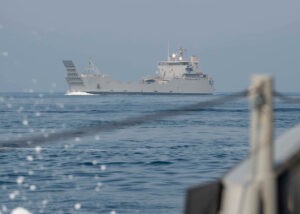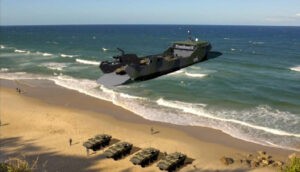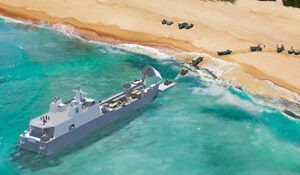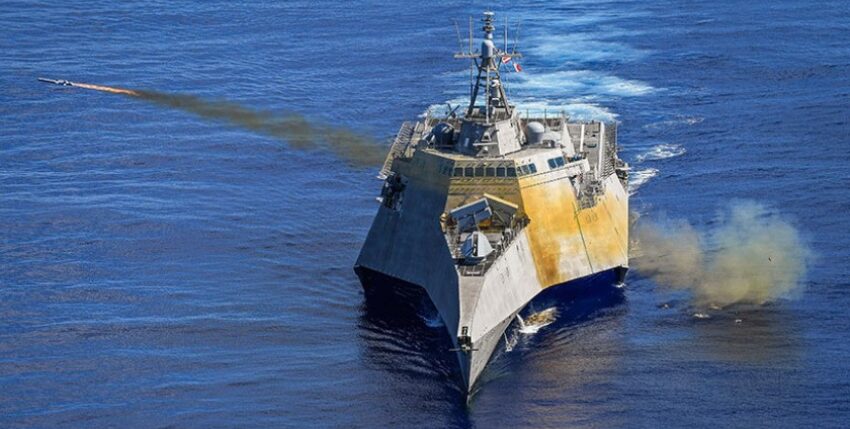The Navy and Marine Corps are planning the joint construction of amphibious units. However, different ideas are jeopardising the success of the project.
The US Navy is planning to introduce a new class of light amphibious warship (LAW) for transporting marines to the theatre of operations. A decision on the ship design is expected to be made in the first half of 2023. With a length of between 60 and 120 metres and a displacement of 3,000 to 4,000 tonnes, the LAW falls into a medium size class from an international perspective. The maximum draught is 3.7 metres to ensure that the ship can approach the landing beach directly and lower soldiers "dry-footed" via a bow or stern ramp.
The Navy is aiming for a maximum speed of around 15 knots and a range of at least 3,500 nautical miles. This comparatively low speed was chosen in order to keep fuel consumption low and thus achieve the eleven-day dwell time at sea.

The ship should have a maximum crew of 40 under the command of a Lieutenant Commander (Corvette Captain). A LAW should be able to carry at least 75 marines. In addition, there is a wide range of equipment for the marines, including vehicle-mounted anti-ship missiles, armed and unarmed UAVs, rocket artillery and fuel and ammunition to supply aircraft. The payload capacity is expected to be around 650 tonnes. There will only be a single transport deck with a footprint of 760 to 950 square metres. The transport deck for vehicles and equipment will be open. The deckhouse will have seating and sleeping space for around 120 people. There will also be suitable duty rooms for mission planning and preparation.
The armament consists of a 25 or 30 millimetre calibre gun and several heavy machine guns. The Navy wants the ships to remain operational long enough after an enemy hit to transfer soldiers and payload to another ship. The aim is to achieve Tier 2+ resilience, which exceeds the protection of the Littoral Combat Ships (LCS). The increase to Tier 3 - whereby a LAW would still be operational even after a single enemy hit - would increase the unit costs to half a billion dollars and is therefore rejected. The new ship class is designed for 20 years of service.
Deployment concept
The LAW is regarded by the Marines as a key element in the implementation of the new operational doctrine in the Indo-Pacific region. The conventional operational concept of the US Marines is based on the approximately 2,200 Marine Expeditionary Units (MEUs). These amphibious battalions, reinforced by artillery and aircraft, are usually kept operational at sea on three large amphibious warships. The new concept of Expeditionary Advanced Base Operations (EABO) complements this conventional structure with the deployment of highly mobile Marine Littoral Regiments (MLRs), which are specifically organised for operations on the islands and atoll groups between Japan and Southeast Asia. This area, designated by Beijing as the first island chain, is regarded by Chinese military planners as a natural barrier against advancing US forces and their allies.
Each MLR regiment has nine reinforced infantry platoons, each with around 75 soldiers. The EABO concept envisages keeping these mobile units at sea or in changing tactical locations in the Asia-Pacific region. In the event of tensions, these scattered units are to immediately take up tactically relevant positions - especially in the area of the first island chain - in order to monitor straits or, if necessary, attack enemy naval, air or land forces. They are supposed to change positions quickly - after a few hours or days - before they can be engaged by enemy forces.

The light amphibious warships are the primary means of transport for the mobile littoral units of the US Marine Corps (USMC). The operational range and the ability of the ships to reach as many potential landing zones as possible thanks to their shallow draught ensure the mobility and flexibility of the USMC units. "These ships will allow the three Marine Littoral Regiments to operate from a standing position to quickly take up positions in strategic straits and [other strategically important] locations before combat operations break out," explained the Deputy Commandant of the USMC, General Eric Smith, at the beginning of September.
The Marine Corps postulates a requirement for 35 units. Nine ships therefore form a squadron. One squadron will be assigned to each of the three Marine Littoral Regiments. The remaining eight units serve as a reserve to replace ships during their maintenance phase.
Escort required
In principle, LAWs should be deployed individually or in formations of the same type, but can also operate together with other warships. The primary deployment concept assumes that the ships operate individually.
Despite its armament and military capabilities, the ship should be able to be mistaken for a merchant ship - at least from a distance or at first glance - due to its size and silhouette, explained Lieutenant General Karsten Heckl, Commander-in-Chief of the Combat Development Command. This should enable LAWs and the marines they carry to remain "under enemy radar".
"The Indo-Pacific waterways are the busiest sea routes in the world," emphasised Heckl. "It would be difficult for any naval power to monitor every point in this region at all times. But you make it so much easier for the enemy if you stand out from your neighbourhood."
In the event that LAWs are nevertheless detected by the enemy, on-board protection is hardly sufficient. As early as 2020, it was determined that a warship equipped with naval target and anti-aircraft weapons should monitor the LAW deployment area in order to neutralise threats. Littoral Combat Ships armed with anti-ship missiles are also being discussed.
Internal dissonance
Although the USMC will be the user of the LAWs, the procurement and operation of the light amphibious warships will be the responsibility of the US Navy. Consequently, a dissonance has developed between the two branches of the armed forces regarding the procurement of the new ship class. The USMC is pushing for the fastest possible introduction, while the Navy wants to postpone the original schedule by two years for budgetary reasons. Another point of contention: the Navy wants to design the ships to be as robust as possible so that they remain operational even in the event of an enemy strike and provide maximum protection for the personnel on board. The USMC is focussing on speed, flexibility and presence. Furthermore, the Navy is considering equipping the LAWs with additional equipment in order to fulfil other tasks beyond troop transport. There is said to be particular interest in equipping them with high-performance sensors to contribute to comprehensive situational awareness. If these wishes are granted, the design changes favoured by the Navy are likely to lead to a significant increase in costs. Consequently, the latest plans presented in July envisage the procurement of only 18 units. However, the USMC sees a need for 35 units and is therefore prepared to accept the risks associated with lighter self-protection.

On 6 October, General Heckl declared that both branches of the armed forces had come closer in terms of the costs and capabilities of the LAWs. According to Heckl, the impending delay to the procurement programme appears to have been largely averted. The cost issue also appears to be slowly coming under control. The Navy's draft budget for 2023 envisages long-term procurement costs of 145 million dollars per ship from the third unit onwards.
Timetable
In June 2021, contracts for concept development were awarded to five competing companies: Austal USA, Bollinger, Fincantieri, VT Halter Marine, and TAI. They are to submit initial designs for such an amphibious warship based on ships already in production or on designs ready for production. The designs derived from the civilian ships are to take into account certain performance specifications of the Navy. The current phase is not least intended for the companies to explain to the Navy the extent to which certain military specifications can be implemented and what operational effects (and cost increases) would arise. These five submissions will be reviewed from January 2023.
In the first half of 2023, the decision to award a contract for the creation of a detailed design and construction (DD&C) to one of the five competing companies is to be made. As part of the DD&C phase, the detailed design will be created and the corresponding prototype built and delivered. If the design and prototype are evaluated accordingly, a contract for pre-series production is to be awarded in 2024.
According to current planning, the contract will be awarded in December 2024 and construction will begin in the course of the 2025 financial year. Delivery of the type ship is scheduled for 2028 and the first unit is expected to enter service in 2029.

Until then, the MLR units will practise on leased civilian transport vessels equipped with stern ramps in order to test operational concepts; lessons learnt from these exercises will also be incorporated into prototype development. Various smaller warship categories are being discussed for operational transport before the LAWs enter service, including the military catamaran ferries (Expeditionary Fast Transport Vessel, T-EPF) and the Littoral Combat Ships. If the LAW programme is cancelled after all - perhaps because the Pentagon decides that the procurement funds are needed elsewhere - other units such as the LCS could end up being used permanently to support the MLRs.
Sidney E. Dean










